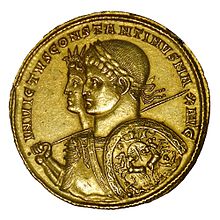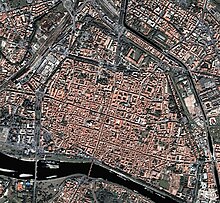Ticinum
This article relies largely or entirely on a single source. (February 2012) |

Ticinum (the modern
It was said by
. Its importance in

The branch to Eporedia must have been constructed before 100 BC. Ticinum is frequently mentioned by classical writers. It was a municipium, but we learn little of it except that in the 4th century there was a manufacturer of bows and a mint there.[1] The first Christian bishops of the city are identified as Juventius and Syrus.[citation needed]
In 271 the Emperor
The city was pillaged by
Saint Damian of Pavia was bishop of the city from 680 to 710.[citation needed]

The name Papia, from which the modern name Pavia comes, does not appear until Lombard times, when it became the seat of the Lombard kingdom, and as such one of the leading cities of Italy.[5] Cornelius Nepos, the biographer, appears to have been a native of Ticinum. Of Roman remains little is preserved; there is, for example, no sufficient proof that the cathedral rests upon an ancient temple of Cybele though the regular ground plan of the central portion, a square of some 1150 yards, betrays its Roman origin, and it may have sprung from a military camp. This is not unnatural, for Pavia was never totally destroyed; even the fire of 1004 can only have damaged parts of the city, and the plan of Pavia remained as it was. Its gates were possibly preserved until early in the 8th century.[1]
The picturesque covered bridge, the
References
- ^ a b c d e f One or more of the preceding sentences incorporates text from a publication now in the public domain: Ashby, Thomas (1911). "Ticinum". In Chisholm, Hugh (ed.). Encyclopædia Britannica. Vol. 26 (11th ed.). Cambridge University Press. p. 934.
- ISBN 0-521-30199-8, p. 223.
- ^ "Details for issuing mint located at Ticinum (Pavia, Italy)". Portable Antiquities Scheme. British Museum and Amgueddfa Cymru. Retrieved Mar 14, 2020.
- ^ Routledge Encyclopedia of Philosophy, entry on Boethius, Anicius Manlius Severinus by Henry Chadwick
- ^ Smith, William (1854). Didtionary of Greek and Roman Geography. London: Walton and Maberly. Retrieved Mar 14, 2020.
